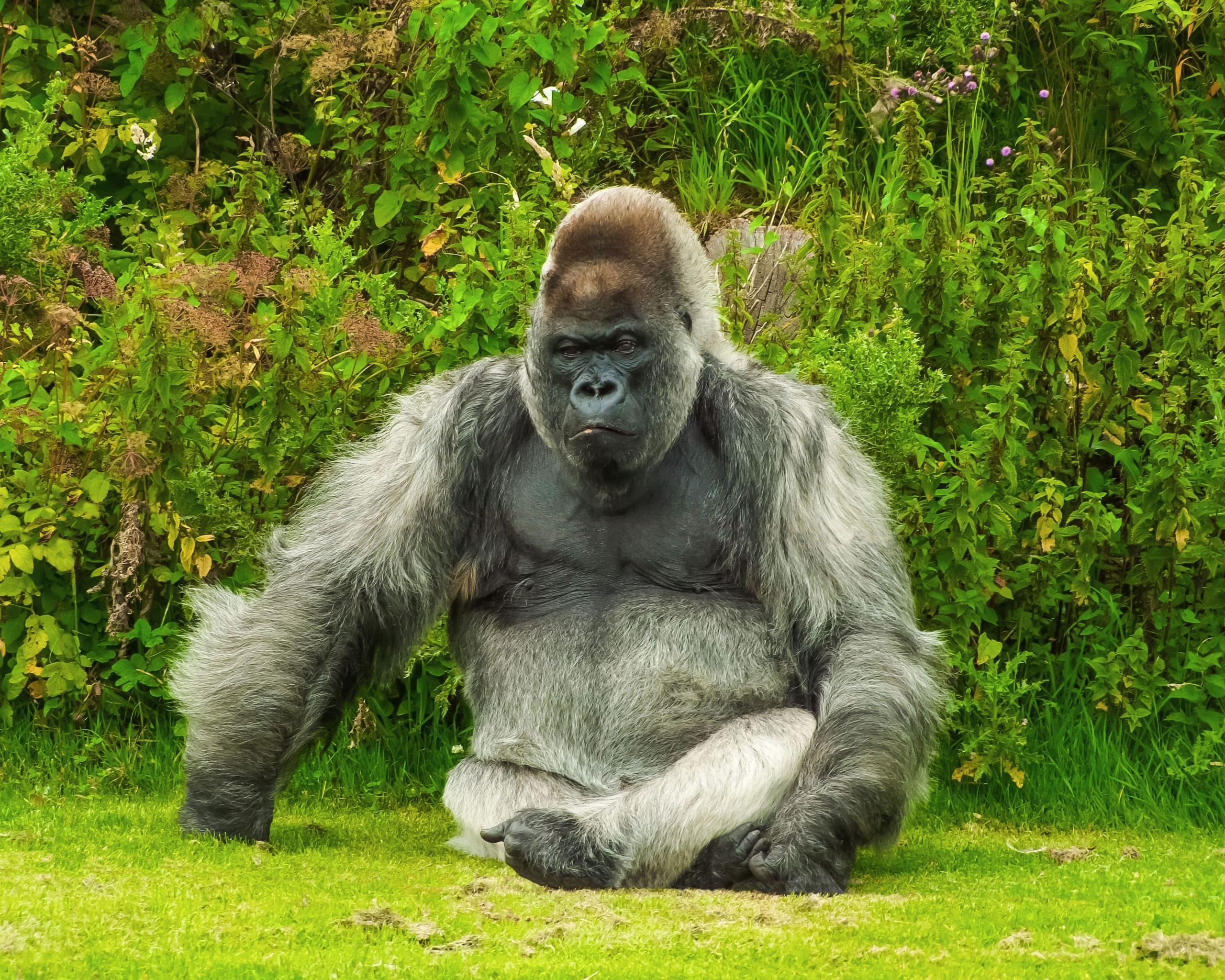Ever wondered about the awe-inspiring size of a silverback gorilla? We’ll delve into the captivating world of these majestic creatures, separating fact from fiction about their weight. Get ready to explore the crucial role their size plays in their social dynamics, their strength, and the challenges they face.
Unmasking the Silverback’s True Weight
Picture a silverback gorilla, muscles rippling, standing tall in the rainforest. These magnificent animals command attention, but just how much does a silverback gorilla weigh? On average, they can tip the scales at a massive 300 to 500 pounds – that’s equivalent to two or three average-sized humans combined!
This impressive size is due to a combination of genetics and lifestyle factors. Like inherited traits in humans, gorillas have genes that influence their growth potential. Their diet, consisting mainly of leaves, fruits, and shoots, fuels their large frames. Additionally, their active lifestyle, filled with foraging, moving through their territory, and engaging in displays of dominance, contributes to their powerful physique.
The Weight of Power: Size and Social Status
In the gorilla world, weight isn’t merely a number; it’s a symbol of power and status. The bigger the silverback, the more respect and authority he commands within his group. This hierarchy is crucial for maintaining order and protecting the family unit.
A silverback’s strength is a testament to his size, allowing him to lift over 1,700 pounds – that’s like hoisting a small car! This raw power is essential for defending the troop from threats and asserting dominance.
Interestingly, weight also plays a role in mate attraction. Larger, stronger silverbacks are often more appealing to potential mates, highlighting the evolutionary significance of size within the species.
The 4000-Pound Myth: Unveiling a Gorilla’s True Strength
You might have heard tales of gorillas bench-pressing a mind-blowing 4000 pounds. While undoubtedly impressive, this claim is more myth than reality. A gorilla’s anatomy, while incredibly strong, isn’t designed for traditional bench presses.
So, what is the real story behind their extraordinary strength? Gorillas possess the remarkable ability to push up to ten times their body weight! This means a 400-pound silverback could potentially push a staggering 4000 pounds – imagine the force required to move a small car!
Their secret lies in their unique physique:
- Longer Arms: Gorilla arms are longer than their legs, providing superior leverage.
- Broad Chests: Their wide chests house powerful chest muscles, essential for pushing and lifting.
- Dense Muscle Fibers: Gorilla muscles are denser than human muscles, generating greater force.
This strength is essential for survival in the wild. They use it to uproot trees, break bamboo, defend their territory, and protect their family group from threats.
Heavyweight Champions: Exploring the Upper Limits of Gorilla Size
While the average wild silverback weighs between 300-400 pounds, some individuals far exceed this norm. The title of “Heaviest Gorilla” belongs to Phil, a captive silverback at the St. Louis Zoo, who reached an astounding 860 pounds – nearly twice the average weight of his wild counterparts!
“The heaviest silverback gorilla ever recorded was a captive gorilla named Phil, who lived at the St. Louis Zoo and weighed an astonishing 860 pounds. This weight is almost double the average for a wild silverback.”
Phil’s extraordinary size is likely attributed to a combination of genetics and a controlled diet in captivity. However, his case also highlights the potential health implications of excessive weight gain in gorillas, just as in humans.
Understanding the weight variations among silverbacks, both in the wild and captivity, provides valuable insights into their overall health, ecological adaptations, and the potential impacts of human influence on their well-being.
Gorilla vs. Bear: A Battle of Titans?
The hypothetical clash between a gorilla and a bear has sparked countless debates. Who would emerge victorious? The answer is complex and depends on various factors.
Size and Strength: Grizzly bears, weighing up to 1,500 pounds, have a significant size advantage over gorillas, which typically weigh between 300 and 500 pounds.
Weaponry: While gorillas possess powerful bites and impressive strength, bears counter with razor-sharp claws and crushing bite forces that can reach over 1,000 pounds per square inch.
Intelligence and Instinct: Gorillas are highly intelligent and strategic, but bears are cunning and possess strong predatory instincts honed for hunting and fighting.
Habitat and Behavior: Gorillas inhabit dense jungles, while bears are found in various environments, including forests and mountains. A fight on a gorilla’s home turf might grant it an advantage, but ultimately, the outcome would depend on the individual animals, their size, experience, and a degree of luck.
It’s important to note that a gorilla and a grizzly bear would likely avoid confrontation in the wild due to their different habitats and prey preferences. This hypothetical matchup, while intriguing, highlights the diverse strengths and adaptations of these magnificent creatures.
Conservation: Protecting the Giants
Understanding the weight and strength of silverback gorillas allows us to appreciate their power and the vital role they play in their ecosystems. Sadly, habitat loss, poaching, and human-wildlife conflict threaten gorilla populations worldwide.
By supporting conservation efforts, promoting responsible tourism, and raising awareness about the challenges these amazing animals face, we can help ensure the survival of these gentle giants for generations to come.
Don’t forget to explore more:
Wondering how long does pink eye bacteria stay on surfaces? The answer may surprise you.
Do you know how many ounces are in 2.7 liters? Find out here, and learn about other conversions too.
- Jesus Bible: Discover Jesus’s Story Throughout Scripture - April 27, 2025
- Don Luis: Unraveling the 16th-Century Virginia Mystery - April 27, 2025
- Captain J’s Kauai Tours: Unforgettable Na Pali Coast Adventures - April 27, 2025
















